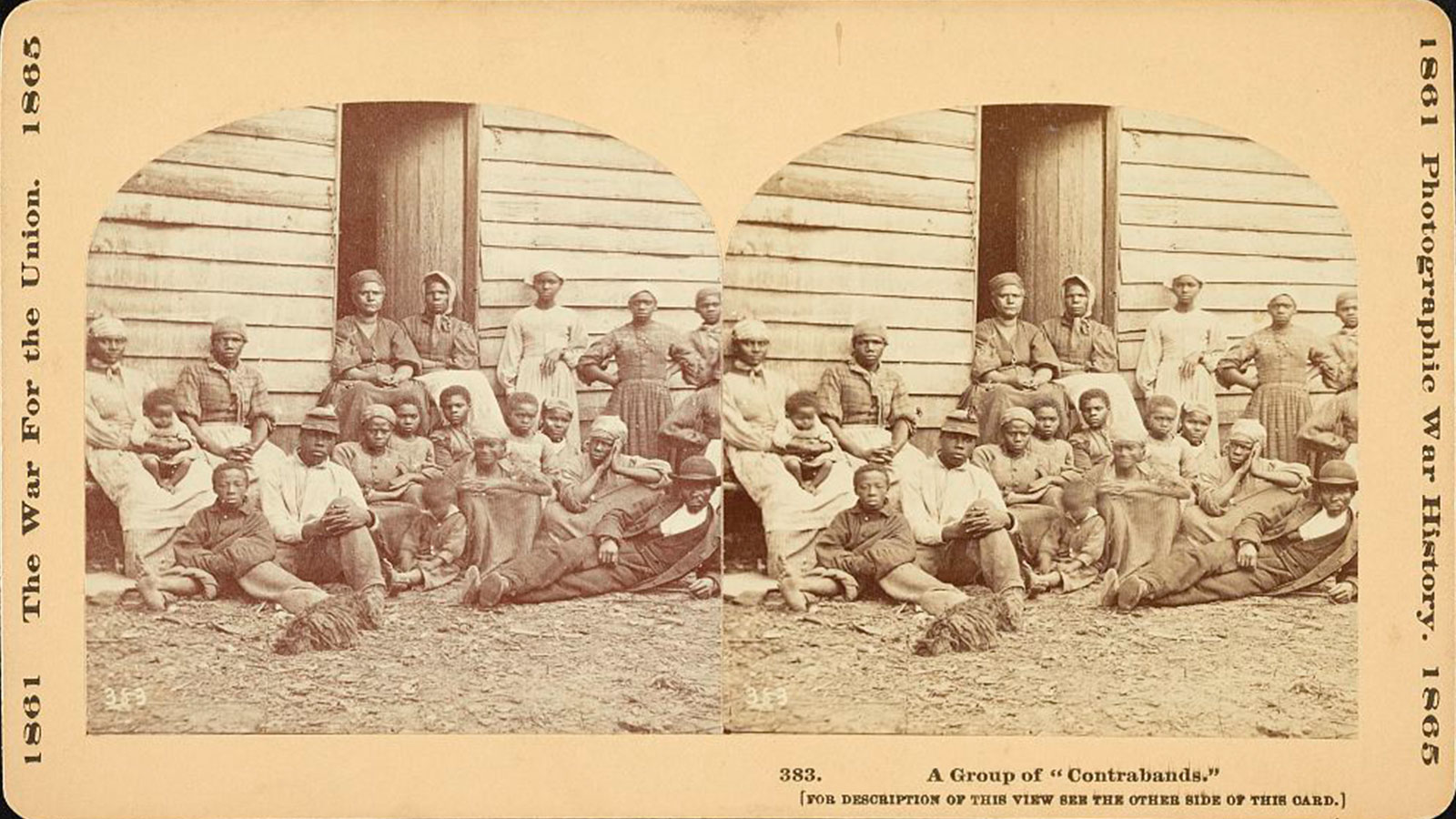We rightly celebrate Abraham Lincoln for helping end slavery. But we shouldn’t forget the unstoppable force that also brought down the Slave Power: the several million slaves who left the plantation, many of whom joined the Union Army.
Several million slaves walked off their jobs over the course of the Civil War. As in most such disputes between workers and employers, the latter provided most of the documentation; the striking workers left little in the way of sources.
Yet we know that from the onset of the war, slaves were increasingly forthcoming about their views. On Christmas Eve 1861, Kentucky whites watched as sixty slaves paraded “singing political songs and shouting for Lincoln.” That winter, as white Unionists sabotaged railroad bridges in the Upper South, Confederate authorities also began blaming disgruntled slaves for arson. At year’s end they blamed unsupervised slaves encamped in Charleston for a fire that swept through the city, destroying hundreds of buildings.
Elsewhere in South Carolina, authorities followed rumors into a swamp where they found an encampment of runaways growing their own crops. Soon after, Confederates in Adams County, Mississippi, found that field slaves had stashed arms and supplies in a similarly isolated maroon. Even as slaveholders repeated rumors of armed slave insurrections, they reported remarkably more pragmatic plans, such as that for “a stampede” of a hundred slaves into the wilderness or toward Union lines.
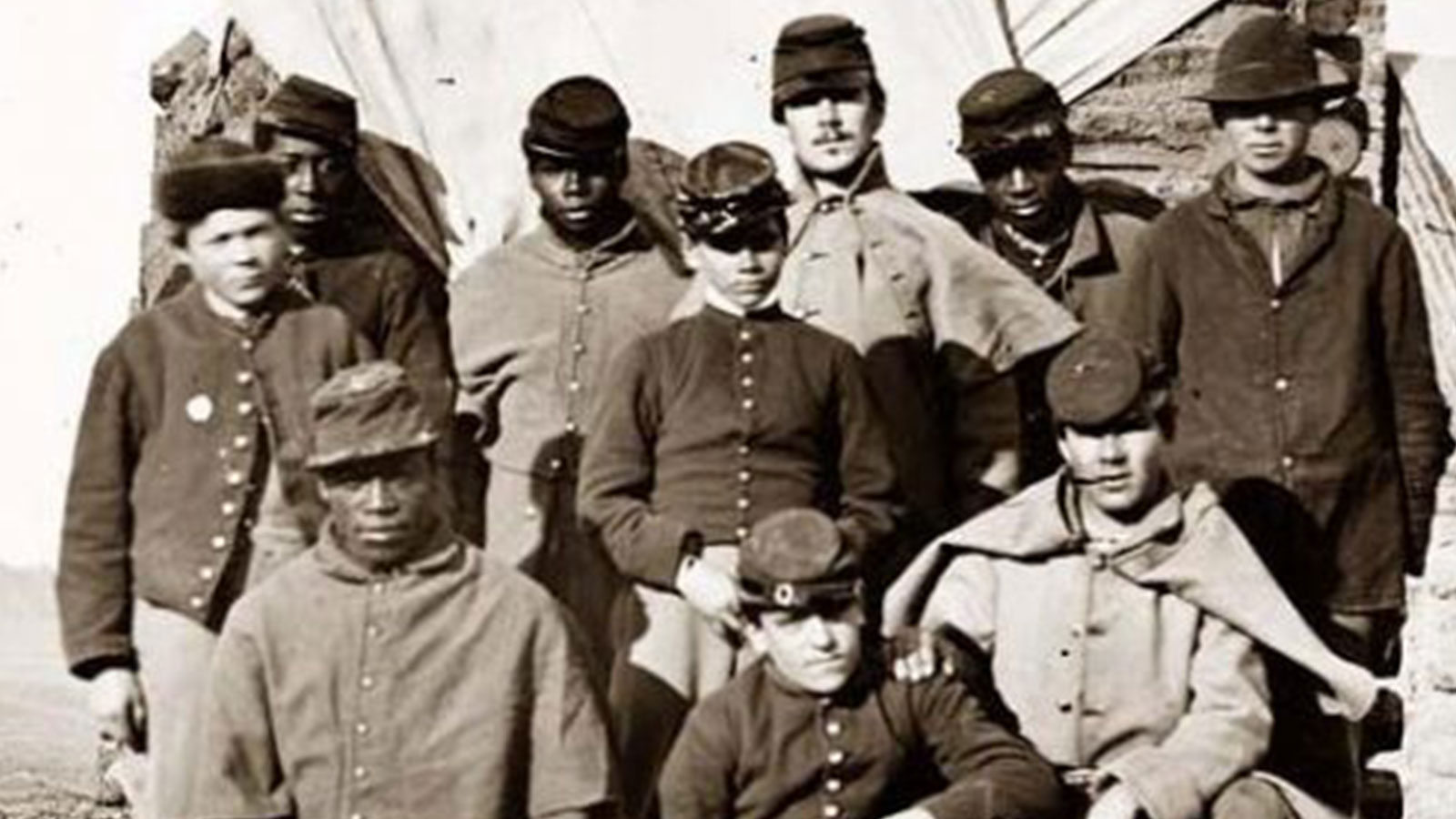
White and black Union soldiers during the Civil War. (Wikimedia Commons)
The authorities responded ruthlessly to maintain their power. Arkansas slaveholders executed blacks for an alleged plot at Monroe, while similar executions took place in May and June across the river in Mississippi. At New Orleans a dozen ships burned at anchor and, “on more than one plantation, the assistance of the authorities has been called in to overcome the open resistance of the slaves.” Similar rumors stirred central Kentucky and Tennessee.
At first, Federal authorities — even those who later became prominent emancipationists — balked at allying themselves with slave insurrection. In the war’s first weeks, General Benjamin F. Butler assured Maryland officials that his troops would prevent a servile insurrection there. As late as August 1862, Butler, then in Louisiana, worried that “an insurrection [that] broke out among the negroes” threatened whites. He squelched “the incipient revolt . . . by in- forming the negroes that we should repel an attack by them upon the women and children.” That fall, a threatened rebellion north of Thibodeaux concerned officials of the Federal occupation.
Confederate paranoia aside, African Americans sustained organizations of their own that pressed their own agenda. Black resistance to slavery had forced white supporters to help shape a new “underground railroad.” Even in the most contested and supervised circumstances in Virginia, enslaved black workers established and maintained their own associations. A Union prisoner at Staunton and a spy at Richmond stumbled onto these societies “composed almost exclusively of colored men.”
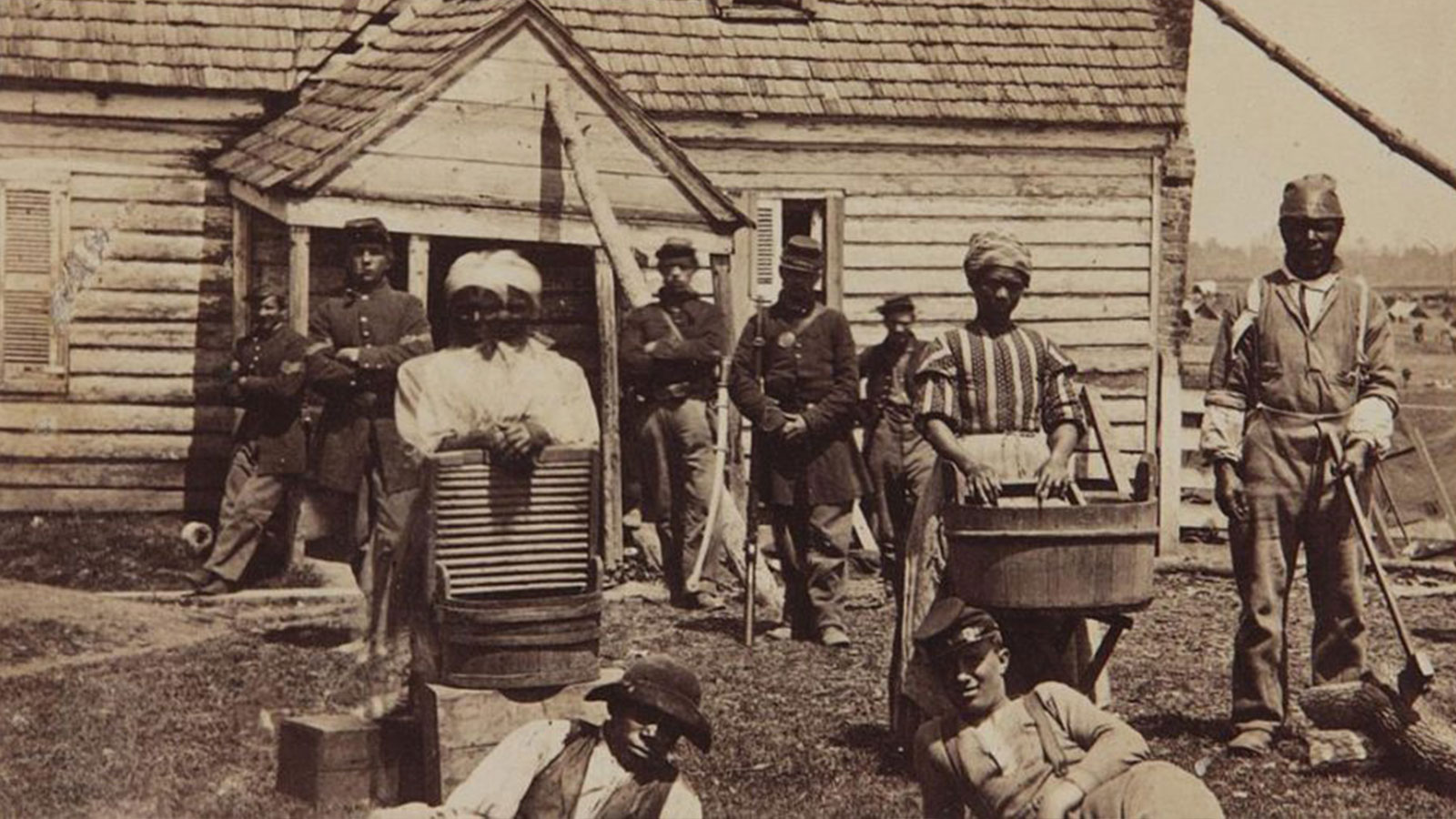
Escaped slaves at a Union general’s headquarters, circa 1862. (Beinecke Rare Book & Manuscript Library, Yale University via Wikimedia Commons)
The growing numbers of aggrieved nonslaveholders, including armed Confederate deserters and escaped Union prisoners, provided slave rebels a growing number of whites ready to transgress the color bar. Civilian authorities far from Federal lines clamored for martial law and the assignment of troops to suppress small bands of armed blacks. Increasingly, Confederates feared a convergence of “deserters from our armies, Tories and runaways.”
By early 1864 Confederate officials in South Carolina reported “five to six hundred negroes” not in “the regular military organization of the Yankees” who “lead the lives of banditti, roving the country with fire and committing all sorts of horrible crimes upon the inhabitants.” Florida officials reported “500 Union men, deserters, and negroes . . . raiding towards Gainesville,” while similar groups formed to commit “depredations upon the plantations and crops of loyal citizens and running off their slaves.” At Yazoo City, Mississippi, they not only attacked such private estates but successfully burned the courthouse.
At times, black resistance fueled the worst Confederate fears, nowhere more famously than in Jones County, Mississippi. A Confederate conscript and deserter named Newton Knight organized and captained a small but effective band of guerrilla fighters.
The rolling strike of the slaves defied the official policies of both governments and made itself the great incontrovertible and irreversible fact of the war. It established the foundations for a substantive interracial cooperation and forced the capitulation of one of those contending governments to rethink and expand its war goals.
Through the summer of 1862, even as President Abraham Lincoln remained aloof from abolitionist proposals, he decided to expand the Union’s goals as commander in chief. In September, though, the president issued his “preliminary proclamation” of emancipation.
The Federal Government and the Transition to Wage Labor
The Federal government accepted emancipation because it had no alternative. The farther the Union armies penetrated into the South, the denser population of slaves responded with a general, though not universal, abandonment of the plantations.
On the Carolina coast, in the lower Mississippi Valley, and in the later march through Georgia, the numbers of enslaved workers who abandoned their labors and escaped to freedom came to outnumber the Union troops who seized and garrisoned these areas. Those who had been the most powerless and downtrodden people on the continent had placed emancipation beyond the control of presidents and generals.
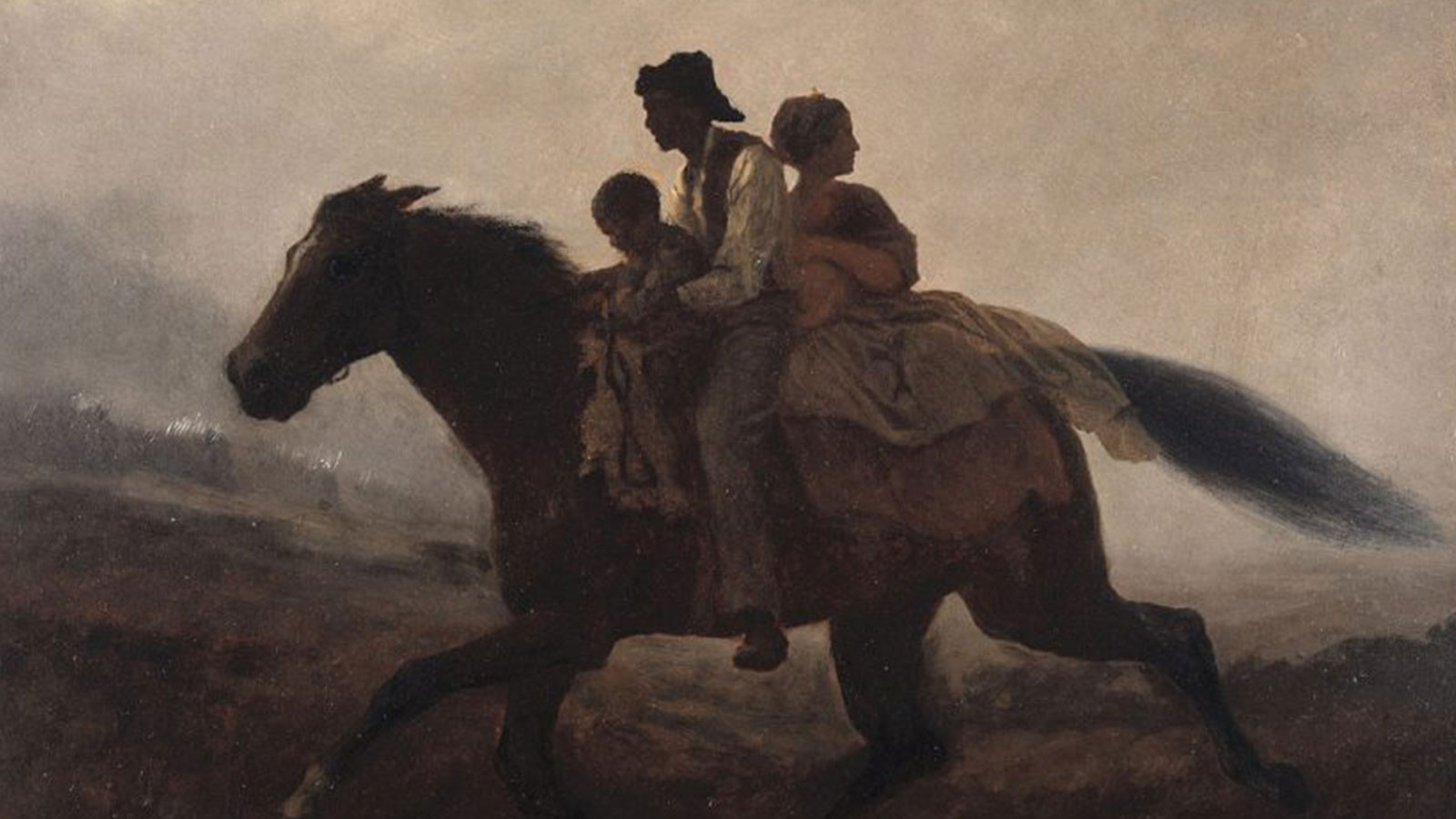
Eastman Johnson, A Ride for Liberty — The Fugitive Slaves, circa 1862. (Brooklyn Museum via Wikimedia Commons)
African Americans had never entirely been strangers to wage labor. Some slaves as well as free blacks had participated in labor activities and organizations. The Waiter’s Protective Union at New York, a decade before the war, had surely not been unique. Almost as soon as the war ended, ongoing black labor discontent gave rise to local “ringleaders” and “troublemakers.” A South Carolina freedman named Sandy was described as one who “works when he chooses, and only such work as he chooses to do . . . all the time exciting the people with falsehoods and rebellions principles.” He and his followers appealed persistently to the Freedmen’s Bureau, but Federal concerns proved to be nothing if not ambiguous.
Associations for mutual aid sprang up across the South, some achieving considerable size and influence. The Church Pension Society of Freedmen at Columbia, South Carolina, appeared quickly enough to hint at older networks among blacks. African Americans in Tennessee established two prominent mutual-aid societies at Memphis and Chattanooga, the former strong enough to support on its own two hundred indigent freed people.
Other associations, such as the Union Progressive Association, organized blacks or sometimes racially mixed memberships. This “literary society of the colored men of Boston” sponsored a celebration of emancipation that drew “a very large attendance, a considerable portion of those present being white.
Most dramatically, the unexpectedly disastrous level of casualties opened one avenue of work, traditionally reserved for whites, to African Americans. As events drove the white South to an ever-heavier reliance on conscription and coercion, the Union turned to black troops. Strikers accounted for most of the roughly quarter-million soldiers who served in the “colored volunteer” regiments, where they performed the same work being performed by whites, though not at the same pay or under the same terms.
Nevertheless, military service imposed similar experiences upon black and white men, and many responded with an acknowledgement of the familiar. “You would be astonished,” Sergeant George Washington Beidelman of the Philadelphia Typographical Union assured his father, “to see in what short time these rough and uncouth, and hitherto despised and ignorant men, attain proficiency as good soldiers — both in drill and discipline. We have many visitors daily — both citizens and soldiers, and all are surprised and delighted. I think the Government has ‘hit the nail on the head’ in this instance; for it is evidently fast becoming its strongest arm for the suppression of the rebellion.”
Despite the Lincoln administration directive to commission black officers, the military high command placed whites in charge of such regiments. Many in power retained the racist expectations that the entire project was but a disaster in the making. Other white officers generally ascribed lesser status to a “nigger colonel” and, with many of the white soldiers, initially accorded black men in arms little respect. Finally, Confederate policy was to regard all black soldiers as slave rebels and their officers as instigators of slave rebellion, liable to summary execution.
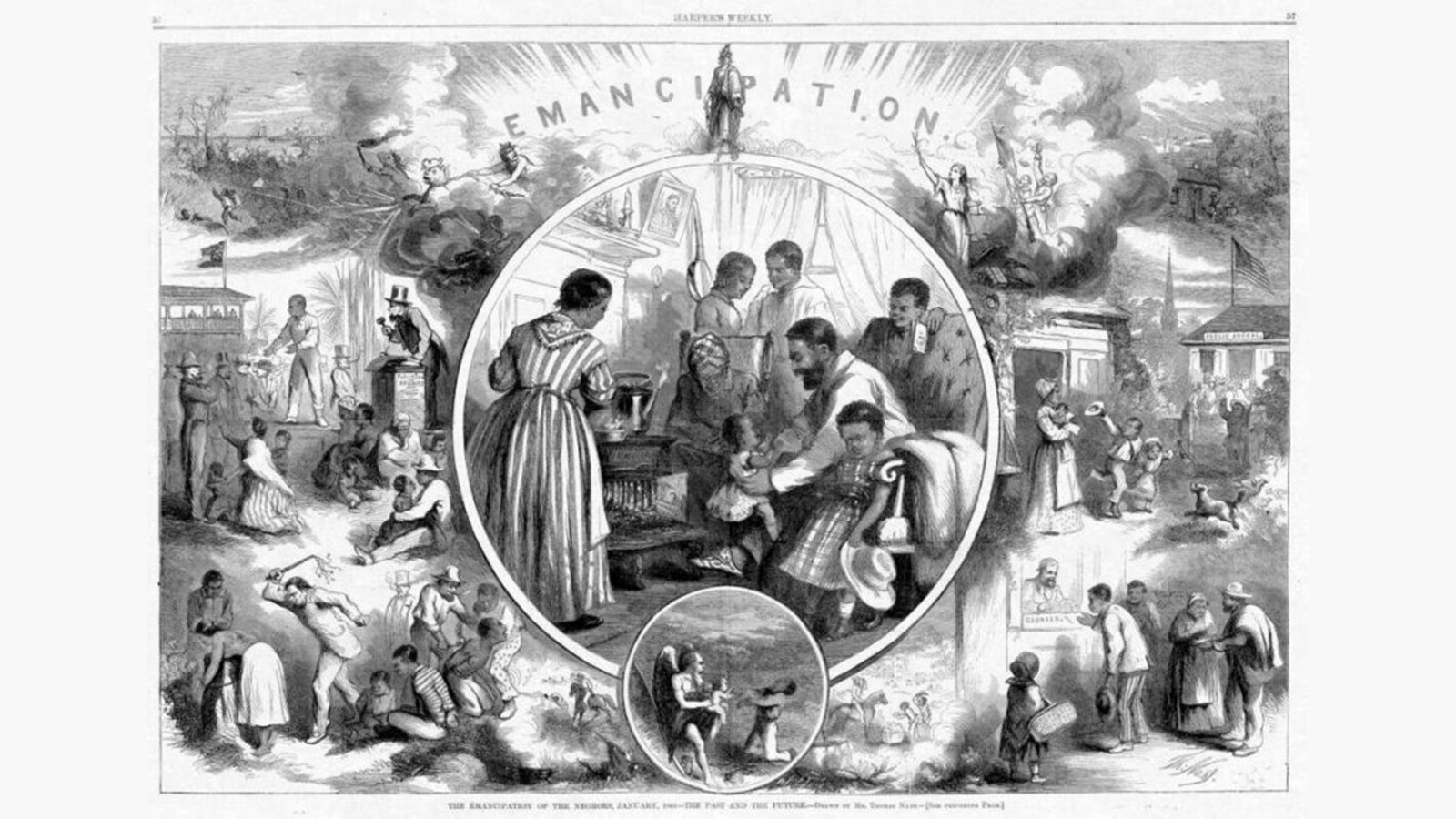
Illustration of emancipation in Harper’s Weekly, 1863. Wikimedia Commons)
Early on, radical abolitionists such as Elizur Wright urged black recruitment as an essential mechanism of a sweeping social reconstruction. Various African Americans became involved in such military activities through the work of a number of important recruiters. Martin R. Delany, James McCune Smith, William H. Day, and Peter Humphries Clark — who had long-standing, if selective, association with white radicals and labor reformers — seemed to see equal participation in the military as a means of fostering a more equal participation in the wider society.
Along the western border of the war, former Chartist and socialist Richard J. Hinton served in the First Kansas Colored, and then the Second Kansas Colored, the Seventy-Ninth and Eighty-Third United States Colored Troops. William H. T. Wakefield, future vice presidential candidate of the United Labor Party, served as a lieutenant among Arkansas black soldiers. The presence of such officers should not obscure the generally miserable experience of African Americans in uniform.
Whites generally chafed under the brutal discipline and hardship of nineteenth-century military life, but most black soldiers faced far worse. More than whites, they got pay, food, and shelter that often looked more symbolic than real. When they responded, as did members of the Corps d’Afrique at Fort Jackson December 1863, the full force of military law fell upon them. While the shadow of such insubordination and its repression might be short among whites, it remained a long, dark, and brooding presence over the African-American experience.
The Politics of Class and Slave Liberation
As Typographical Union brother Beidelman struggled to recover from wounds in both legs gotten at Gettysburg, he reflected on the war’s impact on his own racial views. He entered the war a small-town Jacksonian Democrat with no love for abolitionists or blacks.
However, he decided that emancipation came from “the house of the Lord — the refiner’s fire that will purify our nation.” He publicly challenged a bishop back home who had sermonized that slavery had not in itself been a sin. Recovering at a camp where they trained new black regiments, Beidelman had a transformative experience of interracial camaraderie. “Thank God, the inhuman and hell-begotten prejudices, which would deprive these people of the dearest privileges of men and citizens, are fast disappearing; and a new order of things will no doubt attend the results of this great rebellion and the cleaning out of the Augean stables of our political system.” By his death on March 14, 1864, Beidelman messed and socialized with his new black comrades and wrote of them with open admiration.
African Americans found some strong allies for equality, often with close ties to the abolitionist and antebellum labor currents. However, they were too few, too far between, and too preoccupied with the war to matter greatly until later, and then it proved far too little to counterbalance the great social weight of the plantation elite, particularly as it forgave the nation for its defeat and came back to the exercise of power. Moreover, even as the mass slave strike secured emancipation, Federal responses struggled to translate the achievement into an act of government philanthropy that had nothing to do with what the slaves or abolitionists had done.
But from a labor perspective, the slave strike repressed an uncompromising and overwhelming appeal to numbers. It introduced a qualitatively new kind of mass action.
Adapted from Free Labor: The Civil War and the Making of an American Working Class by Mark A. Lause. Used with permission of the University of Illinois Press. Copyright 2015 by the Board of Trustees of the University of Illinois.
Source: Jacobin
Featured image: Stereograph showing a group of escaped slaves including men, women, and children gathered outside a building at the Foller Plantation in Cumberland Landing, Pamunkey Run, Virginia. May 14, 1862. (James F. Gibson / Library of Congress via Wikimedia Commons)

